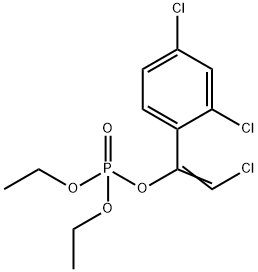CHEMICAL AND PHYSICAL PROPERTIES
| Physical Description | Chlorfenvinfos is an amber-colored liquid with a mild chemical odor. Used for control of ticks, flies, lice, and mites on cattle and for blowfly, lice, ked, and itchmite on sheep. Controls fleas and mites on dogs; not used on cats. Applied on organic wastes and breeding places of fly larvae. Also used as a foliage insecticide for potatoes, rice, maize, and sugar cane. Used to control soil insects. (EPA, 1998) |
|---|---|
| Color/Form | Colorless liquid |
| Odor | Mild odor |
| Boiling Point | 333 to 338 °F at 0.5 mmHg (EPA, 1998) |
| Melting Point | -9 to -2 °F (EPA, 1998) |
| Solubility | Miscible with most common organic solvents, e.g. acetone, ethanol, kerosene, xylene, propylene glycol, dichloromethane, hexane. |
| Density | 1.36 at 59.9 °F (EPA, 1998) - Denser than water; will sink |
| Vapor Pressure | 4e-06 mmHg at 68 °F (EPA, 1998) |
| LogP | log Kow = 3.81 |
| Stability/Shelf Life | SLOWLY HYDROLYZED BY WATER OR ACID, 50% DECOMP OCCURS AT 38 °C IN GREATER THAN 700 HR AT PH 1.1, GREATER THAN 400 HR AT PH 9.1, BUT UNSTABLE IN ALKALI--AT 20 °C 50% LOSS OCCURS IN 1.28 HR AT PH 13. |
| Decomposition | When heated to decomposition it emits very toxic fumes of hydrogen chloride and POx /phosphorus oxides/. |
| Corrosivity | Corrosive to metal |
| Refractive Index | INDEX OF REFRACTION: 1.5281 AT 20 °C/D /Z-ISOMER/ |
| Other Experimental Properties | IT IS A MIXTURE OF THE CIS & TRANS ISOMERS OF THE PHOSPHATE |
| Chemical Classes | Pesticides -> Organophosphate Insecticides |
SAFETY INFORMATION
| Signal word | Danger |
|---|---|
| Pictogram(s) |
 Skull and Crossbones Acute Toxicity GHS06  Environment GHS09 |
| GHS Hazard Statements |
H300:Acute toxicity,oral H311:Acute toxicity,dermal H410:Hazardous to the aquatic environment, long-term hazard |
| Precautionary Statement Codes |
P264:Wash hands thoroughly after handling. P264:Wash skin thouroughly after handling. P270:Do not eat, drink or smoke when using this product. P273:Avoid release to the environment. P280:Wear protective gloves/protective clothing/eye protection/face protection. P301+P310:IF SWALLOWED: Immediately call a POISON CENTER or doctor/physician. |
COMPUTED DESCRIPTORS
| Molecular Weight | 359.6 g/mol |
|---|---|
| XLogP3 | 3.1 |
| Hydrogen Bond Donor Count | 0 |
| Hydrogen Bond Acceptor Count | 4 |
| Rotatable Bond Count | 7 |
| Exact Mass | 357.969529 g/mol |
| Monoisotopic Mass | 357.969529 g/mol |
| Topological Polar Surface Area | 44.8 Ų |
| Heavy Atom Count | 20 |
| Formal Charge | 0 |
| Complexity | 368 |
| Isotope Atom Count | 0 |
| Defined Atom Stereocenter Count | 0 |
| Undefined Atom Stereocenter Count | 0 |
| Defined Bond Stereocenter Count | 0 |
| Undefined Bond Stereocenter Count | 1 |
| Covalently-Bonded Unit Count | 1 |
| Compound Is Canonicalized | Yes |
PRODUCT INTRODUCTION
description
Chlorfenvinphos is an insecticide that is a colorless liquid with a mild odor. It was commonly used until 1991 when all products containing chlorfenvinphos as an active ingredient were canceled in the United States. Commercial preparations commonly sold in stores were usually 90% chlorfenvinphos. Most of the chlorfenvinphos used was in liquid form. Chlorfenvinphos was widely used to control household pests such as flies, fleas, and mice. The chemical is manufactured and does not occur naturally in the environment. It was sold under common trade names including Birlane®, Dermaton®, Sapercon®, Steladone®, and Supona®. Use of trade names is for identification only and does not imply endorsement by the Agency for Toxic Substances and Disease Registry, the Public Health Service, or the U.S. Department of Health and Human Services.
